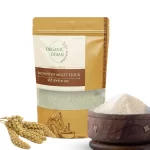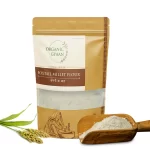Description
Siridhanya millet flour comprises of 5 positive millets flour:
- Little Millet Flour
- Foxtail Millet Flour
- Barnyard Millet Flour
- Kodo Millet Flour
- Browntop Millet Flour
They have been cultivated for thousands of years as a staple food in many parts of the world. Our Siridhanya millet flour is made by following a very authentic process first the millets are soaked, then dried and later stone-ground into a fine powder. By doing so, the siridhanya millet flour retains the highest nutritional value and can be used in a variety of dishes.
Siridhanya millet atta is rich in essential nutrients, including vitamins, minerals, and fibre. It is also gluten-free atta, making it an ideal food for people with celiac disease, gluten intolerance, or wheat allergies. Siridhanya flour has a low glycemic index, which means it does not cause a rapid spike in blood sugar levels, making it an ideal food for people with diabetes. It is also an excellent source of magnesium, which has been shown to help lower blood pressure and reduce the risk of heart disease. It also contains antioxidants that help protect the body from harmful free radicals and boost the immune system.
You can use our siridhanya millet flour in a variety of dishes, including bread, muffins, pancakes, and porridge. It has a mild, nutty flavour and a slightly sweet taste, making it a versatile ingredient in both sweet and savoury dishes. Overall, consuming Siridhanya millet flour can have a positive impact on your health, especially when combined with a healthy and balanced diet. Its nutrient-rich composition, gluten-free nature, and versatility make it a great addition to any diet.
How Activated Flour is Made
Certainly, the process you’re describing involves soaking the millets, sun-drying them, and then stone grinding them to create activated flour. This method is commonly used in traditional food preparation and has its own set of benefits.
Here’s a more detailed step-by-step guide based on the process you’ve mentioned:
Ingredients and Equipment:
1. Millets (any variety you prefer)
2. Water for soaking
3. Stone grinder or any suitable grinding equipment
Instructions:
1. Soaking:
- Measure the desired amount of millets and rinse them thoroughly under running water.
- Place the millets in a bowl and cover them with enough water. Allow them to soak for 6 to 8 hours. This soaking process helps soften the millets and makes them easier to grind.
2. Sun Drying:
- After soaking, drain the water from the millets.
- Spread the soaked millets evenly on a clean cloth or tray to allow them to sun-dry. Ensure they are exposed to sunlight for several hours until they are completely dried. The drying process may take a day or more, depending on the sunlight available.
3. Stone Grinding:
Once the millets are thoroughly dried, use a stone grinder or any suitable grinding equipment to grind them into flour. The stone grinding method is often preferred for its ability to retain the nutritional integrity of the grains.
4. Sieve if Necessary:
After grinding, you may choose to sieve the flour to achieve a finer texture, removing any larger particles.
Activated millet flour obtained through this process is likely to have a distinct flavor and nutritional profile due to the traditional methods used. It can be used in a variety of recipes, such as bread, pancakes, or other baked goods. Always follow food safety guidelines and use the activated millet flour as specified in your recipes.




Reviews
There are no reviews yet.